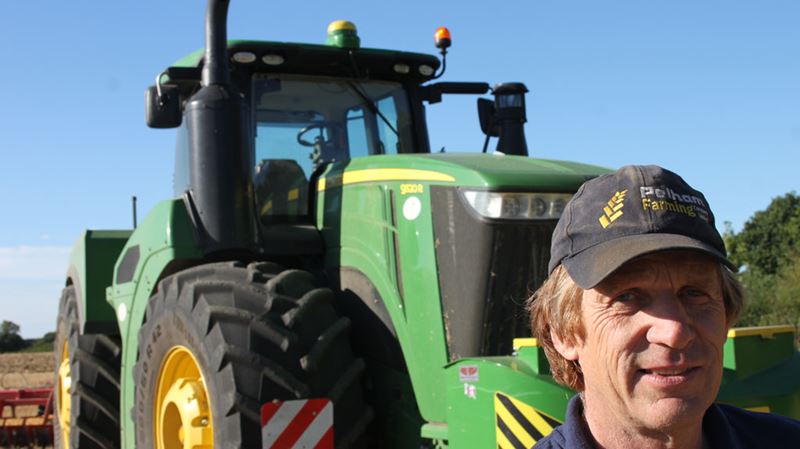Ian Watson

And while the operation has recently changed the make of the machines that head up its fleet, it has stayed with Trelleborg as its preferred tyre supplier after finding alternatives too soft at the same pressure.
Before 2000, when neighbouring family farming businesses Arnold Hitchcock & Co and George Watson & Sons pooled their key combining and cultivations/drilling machinery resources to form Pelham Farming, the two had been running Ford/New Holland wheeled articulated tractors for primary cultivations, but felt the machines weren’t suited to sowing tasks. This meant that when it came to choosing a new power unit for their combined operation, they switched to a twin-track crawler for their new venture. More recently, though, advances in tyre technology have brought them back to wheeled tractors for all of their autumn and spring land work, including both cultivations and drilling. And with the more recent addition of fellow local farmers D E Collins & Son to the group of shareholders having further expanded the business’s land area, plus growing demand from neighbouring farms for contract services, the adoption of wheeled machines for primary tasks has proven to be the right one, maintains Pelham Farming’s Ian Watson.
“The biggest advantage is in terms of costs – whether for a twin-track machine or a four-tracked articulated model, the initial investment is considerably less than for a crawler of the same power. Added to that, with no track undercarriage components to service, the time and investment required for maintenance is also far lower,” he points out.
“On the road tyres make for a much smoother ride, while in the field modern longer-footprint types provide a ground contact area similar to that of a crawler while still falling within transport width restrictions, and in the field we don’t get the headland damage that turning with a twin-track machine can cause.
“But having had considerable experience with two different makes of articulated tractor, we have found that tyre choice can make a significant difference to performance.” The business currently operates a pair of 560hp John Deere 9560R tractors, but previously ran a brace of similarly-powered New Holland T9.560s. One thing that hasn’t changed, though, is big tractor tyre choice.
“We switched to Trelleborg TM900 High Power tyres when operating our previous machines, after finding that the sidewalls of the tyres originally fitted to them, despite being suited to low pressure operation, were too soft and flexed too much,” explains Ian.
“This also created some transport issues, as the tyre bulge made the tractor that little bit wider.
“When we talked with Trelleborg about the High Power TM900s, we were promised we could operate them at similarly low pressures, but that the tyre carcase would give us the long footprint we were looking for without that bulge issue. Since we’ve switched, that has proven to be the case, although we do run them with a little more air than the minimum recommended, for maximum traction.”
Fitted with 900/60 R42 TM900s, the two Deere artics, which are only just over 3.0m wide despite the amount of ground contact area they deliver, provide the power for equipment including 4m Kverneland Stubble Finisher and 6m Vaderstad TopDown cultivators, 8m Horsch Sprinter and Vaderstad Rapid drills, and a twin-leg moledrainer.
Apart from economies of scale, a key reason for the foundation of Pelham Farming was to gain the timeliness benefits that high-output equipment would create. That’s been boosted further by the ability of the wheeled tractors to travel on damp soils without smearing and make headland turns without scuffing.
“Neil Sharman at Trelleborg helped us to set up the tyres and provide us with pressure and load charts according to the weight of the tractors and the load imposed on them by the implements they are paired with. Although it was suggested we could run them lower still, with 1.0t weight on the front and 500kg on each wheel, we operate at 1.3 bar (20psi), and find this gives us very good traction and fuel consumption. When working with the 7m TopDown the tractors’ diesel use is around 105 litres/hr, at around 22l/ha.
“Because we are minimising soil damage, using wheeled tractors with long-footprint tyres has also helped to limit our need for subsoiling to repair compaction damage to once every three years.”
But it’s not just about in-field performance. With Pelham’s operations currently extending across a 12-mile radius from its base at Stocking Pelham, the ability to be able to travel swiftly and safely is also important. That favours tyres over tracks, particularly with the tendency of the latter to give a harsh ride at high speeds, suffer from high wear rates and, along with their associated running gear, heat up during long periods of road travel.
The tractors have been costed over a lifespan that covers their extended five-year warranty periods, although with one now two years old, and the other an ex-demo machine bought in early 2016, they are likely to be replaced on a staggered basis. Working 14-16 hours/day during peak cultivation and drilling periods, the two Deeres clock up approximately 700 hours apiece annually. And because the tractors are almost always working on top of the land with the cultivators and drills, and not performing deep primary cultivations other than rotational subsoiling and some moledraining, it’s anticipated the tyres should last for a good portion of their time with the business.
“With the traction, flotation and road transport benefits we get from running the TM900-tyred wheeled articulated tractors, I can’t see a reason to switch back to tracked machines,” says Ian.
“And that’s especially true once the purchase and running costs are factored in.